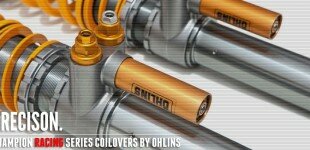Featured Posts
Protected: Beta Testing
GT2 Turbochargers Explained.
Hi guys. So recently we’ve had a few customers express some interest in GT2 turbos as an upgrade from their existing VTG’s, so I thought I’d take a minute to show how the GT2 turbos are different from standard VTG’s, and hopefully make some people’s decisions on upgrades a little easier. A customer sent his factory GT2 turbos in for our CMS billet upgrade, so this was the perfect opportunity to snap a few pictures of the stock GT2 for reference. For the sake of this comparison, we’ll be using 3 examples:
* Stock GT2 Turbo
* Standard Champion Billet Turbo
* Champion Billet Turbo with ported exhaust inlet
Since the factory GT2 turbo uses the same compressor housing and wheel as the standard VTG we’ll focus on the turbine side, which is where the differences are. There are basically 3 differences between a stock GT2 VTG turbo and a stock VTG, all 3 are on the turbine side.
The picture below shows all 3 turbos side by side:
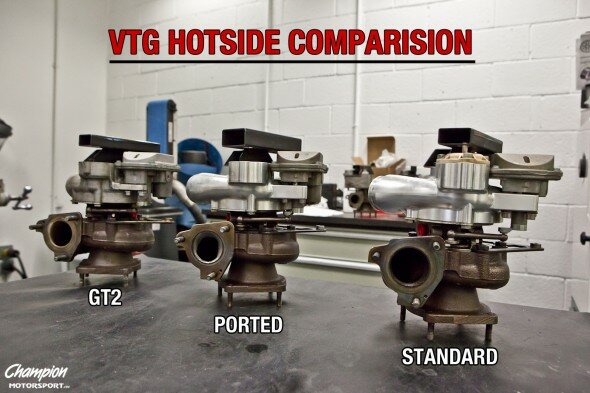
From the outside, the turbine housings look pretty much identical, but the GT2 turbine housing is actually made from a different material, to aid in cooling efficiency. That’s the first difference.
The second difference is that the turbine wheel on a GT2 turbo is “clipped”, which you can see on the closest edge of the turbine blades in the picture below. Notice the very small flat surface on each of the turbine blades. This is done to essentially slow the rotation of the turbine wheel and prevent it from spinning at a rate beyond the flow capacity of the compressor housing. By making sure that the turbine and compressor sides of the turbocharger are working in harmony, this again increases the turbochargers overall efficiency, which in turn reduces the amount of heat generated by the turbo.
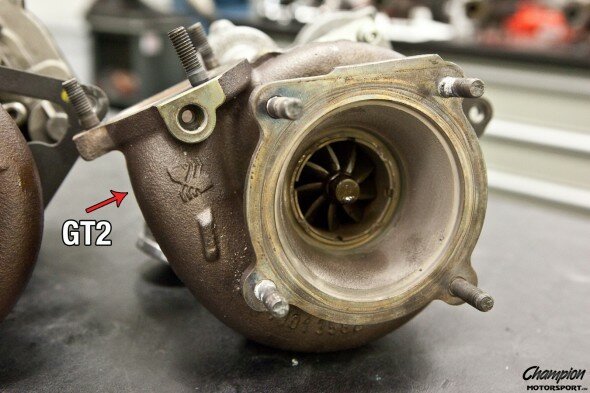
And lastly, the final unique thing about the factory GT2 VTG turbo is the “profile” of the turbine inlet, or effectively the A/R (area/radius) of the turbine inlet. As you can see in the picture below, the GT2 turbo has a much straighter inlet, again an attempt at increased efficiency. It also creates a slightly larger A/R for the GT2 turbine housing.
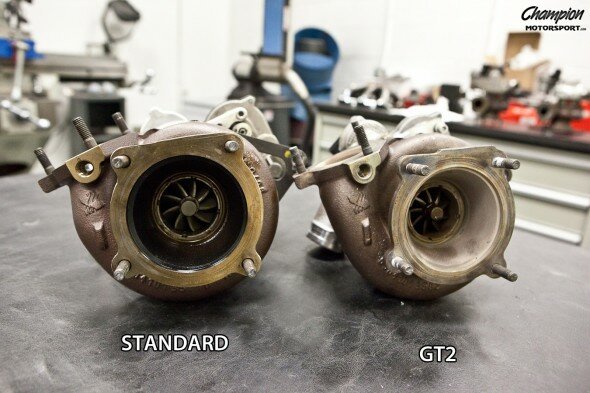
All VTG upgrades, including our own CMS Billet Turbos, leave the factory turbine housing intact, although we do make some proprietary changes to the turbine housing, such as clipping similar to the stock GT2 wheel. One thing we do offer as an option is porting of the turbine inlet. Unfortunately it’s nearly impossible to extrude and hone the entire turbine housing because of the extremely fragile nature of the VTG vanes inside the housing, but porting is a good option for increasing efficiency of the inlet and creating a slightly larger effective A/R. In the two pictures below, you can see two comparisons: Stock VTG vs. GT2, and Stock VTG (ported) vs. GT2.
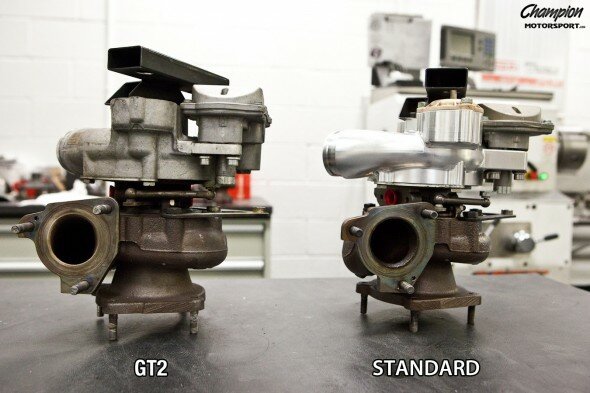

Although it’s a bit difficult to see in the pictures, the ported inlet of the standard VTG turbine housing replicates the GT2’s inlet profile much closer, again slightly increasing the A/R of the turbine inlet, which provides a much greater match to our redesigned billet compressor housings.
So, hopefully this little bit of information will be helpful to some folks who are undecided about which direction they want to go with turbochargers. Overall, although there ARE a few small differences between the stock VTG and the GT2 VTG, the big question everyone wants to know is how this translates to power. Will GT2 turbos offer a slight power upgrade compared to standard turbos….yes. But, realistically the gains you can expect are going to be minimal. The most notable gain will be in efficiency. Any time you can improve efficiency, you’re likely to gain power. How much power depends largely on the quality and performance of all your other hardware upgrades.
Leave a Reply
You must be logged in to post a comment.




